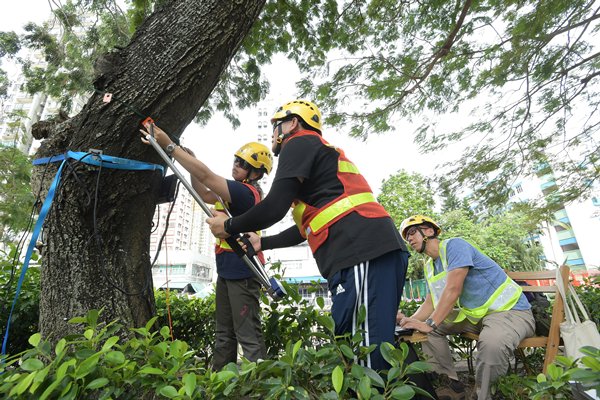Tree Care Saves Lives

With tens of millions of trees in Hong Kong, the Government takes proactive steps to enhance public safety ahead of the wet season. It plants different species along streets with the goal of improving ecological health and minimising tree risks.
Some of the dangers include trees falling due to decay or infestation by pests or diseases along with falling branches.
Diagnosing trees is no easy task. Some may look ready for the axe, but can survive for many years to come, while others that appear perfectly healthy on the outside may in truth, be very sick and ready to fall.
Maintaining trees is indeed a science. Just ask Leisure & Cultural Services Department Leisure Manager (Tree) Clarence Chan, who has managed trees for almost a decade.
“When we conduct tree inspections, we will first take a look at the tree’s crown, leaves, branches, main trunk and roots, to see if there are any abnormal conditions.
“We will check its crown density, leaf colour and size; whether cross branches and dieback are present; any cavities on the trunk and pests and diseases.”
Innovative tools
If a tree’s health looks questionable, that is when advanced equipment such as resistograph and tomography, which can see inside a tree, are used, said Mr Chan.
The goal is to inspect the tree’s interior for cavities and cracks that may signal trouble.
When using sonic tomography, tree experts install metal nails equipped with sound receivers around the stem of the tree. By tapping on the nails, sound waves are generated. From those sounds, a two-dimensional image revealing the cross-section of the tree is shown on a computer.
Different zones of the tree are colour-coded and indicate degrees of decay.
“Tomography works on the principle that sound waves take different times through wood with different density,” Mr Chan explained.
However, tomography cannot be applied to smaller trees. When faced with that situation, Mr Chan said tree experts turn to another useful instrument called the resistograph, which drills a tiny needle connected with a sensor into the wood.
It measures the correlation of drilling resistance to wood density. That resistance is used to analyse the structural condition of the tree. The tiny hole closes itself up without any damage to the tree.
Bird’s-eye view
In addition to scrutinising the trees at ground level, drones are deployed to enable inspections at the highest of angles.
“Drones can reach above the top of the tree crown to gather more information for tree assessment, at the same time eliminating the risk of climbing up the tree,” Mr Chan said.
While all means are used to protect and keep trees healthy, there are times when removing and replacing trees is necessary.
“The mitigation measures include pruning, pest and disease control, and also attaching a cable to enhance the tree support. If no other viable measures can be used, we will consider removing the dangerous tree to enhance public safety,” Mr Chan added.
Planting plan
Along with the maintenance of trees, the Government plants different species along streets with the goal of improving ecological health and minimising tree risks in certain areas.
This is why the Development Bureau has published the Street Tree Selection Guide.
It features 80 less commonly used tree species that are suitable for street planting in Hong Kong and is used as a reference for government departments and anyone else interested in planting unique tree species.
Development Bureau Landscape Architect Allen Cheung said the objective of formulating the guide is to introduce a systematic method for choosing trees that will thrive in the right area.
“The aim is to explore the possibility of planting a higher diversity of tree species and planting the suitable native species, in order to improve the resilience of urban forests and in a way to promote the vegetation diversity.”
Hong Kong was hit by a super typhoon last year that destroyed more than 60,000 trees. The Development Bureau has replanted specific species of trees according to the guide. At Tseung Kwan O’s seaside, the Fox Tail Palm was planted.
Mr Cheung said the palm tree is very suitable for street planting, resistant to pests and disease and has a high wind tolerance.
Taking into consideration the environment of each street is the most crucial aspect of selecting trees, he added.
The guide also includes a data sheet that breaks down each tree species and their resilience to various urban planting environments, distinctive characteristics, species features, and a lot more.
New Hub Helps Green Tech To Flourish
Last month, the Hong Kong Science & Technology Parks Corporation, or HKSTP, transformed its InnoCentre in Kowloon ... Read more
MICE Tourism Gains Momentum
Ballroom inspections and mahjong sessions may not be what automatically springs to mind when you consider Hong Kong’... Read more
Game Startups Reach New Level
The global video game industry is highly competitive, requiring effective marketing for success. The Hong Kong Game En... Read more
Breast Milk Donations Save Lives
Last April, Ida Chan welcomed her son into the world. He was born a kilogramme lighter than expected, and Ida decided ... Read more
HK Reaches For The Moon
The beauty and mystery of the Moon have captivated the human imagination for millennia. Channelling that fascination i... Read more
Creating Disability-inclusive Jobs
Nestled in the Museum of the War of Resistance & Coastal Defence, Madam Hong Cafe enjoys the spectacular views of ... Read more

